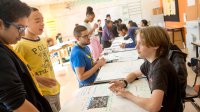Keeping Learning Real, Relevant, and Relatable
Reading and writing exercises teachers can use to tap students’ interests and experiences in a variety of classes.
Our students are reading all day long—text messages on their phones, emailed directions about homework, apps from advertisers. They read what interests them and what helps make their world a more real, relevant, and relatable place to live. And we can tap into their interests to embed speaking, listening, reading, and writing in classes to help achieve content objectives.
Keep It Real
Students want to learn about things that have an impact on them in their daily lives.
Example: Give students an opportunity to learn about where they live by researching how culture, religion, and traditions have shaped their community and perhaps their lives as well. As you introduce this lesson in history or social studies, remember that some students might feel proud of their community, but others might be embarrassed about where they live, and still others might feel indifferent. For many students, their demographic reality is something they have no control over. But where we live does have a real impact on us. Ask your students: How do our neighborhoods define us, our families, and our neighbors?
Have students learn about the history of their neighborhood by researching it. Who were the first people to move to that particular part of town? As an example, what was their ethnic background? Was that particular part of the community more rural than urban, more industrial than agricultural?
Next, ask students to locate vintage pictures of their community from various websites. What can students infer from the pictures? Or invite neighborhood senior citizens to school to share their memories. How has their community changed? How has it stayed the same?
Finally, ask students to explain what they learned about their neighborhood. Students could share their community through more pictures or other artistic representations, or through interviews with senior leaders of their community.
In this scenario, keeping it real means sharing their neighborhood and explaining in creative ways how we are tied to the culture, traditions, and people around us.
Keep It Relevant
Students want to be connected to their learning and in control of it. When planning a lesson, think about the connections students will be able to make.
Example: Students are often tasked with writing a creative reflection about their last family vacation in English class; however, many students have never gone on a family vacation. The writing holds no connection to those students and creates a gap between those who have taken this kind of vacation and those who don’t have the means or opportunity. As a result, this assignment is busywork for some students.
Instead, give students in-class time to write a “Dear Teacher” letter to tell you about their family, their academic background, and their hobbies. This lesson can work in any class, not just English, and you may be able to apply the letter to your lessons, keeping your students connected to their learning in a very personal way.
In this example, you have used a culturally responsive, universally designed lesson to include all students in a relevant way.
Keep It Relatable
How do we connect student interests to their textbook or other required reading? Asking students to study what they find interesting in the text is not enough. However, offering choice within those texts might help.
Example: The next chapter in students’ world history text is ancient Rome. As you explain and highlight the textbook features of the chapter, offer choices of study within the text: During your preview of their required text, ask students to jot down the subheadings, questions, or pictures they find interesting.
Next, create small groups based on student interests. One group might want to research the early years of the republic, another might want to study ancient ruins, and another might want to investigate the power of Rome.
Give groups time to research their interests and prepare presentations based on information within the text and perhaps one or two outside sources. Then give them the opportunity to share their information in rotation stations, with students moving from one station to another to learn from their peers about their interest of study.
In this way, students are able to relate to the content by taking ownership of their learning.
Creating real, relevant, and relatable lessons might mean giving up some teacher control to dialogue with students about what they want and need to be successful. However, if you empower students to share their passions, perceptions, and progress in a deeply meaningful and personal way, your lessons become more creative and imaginative, and give students an opportunity to lead their learning.
